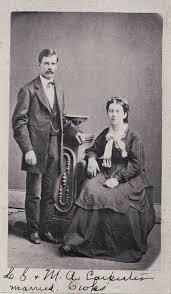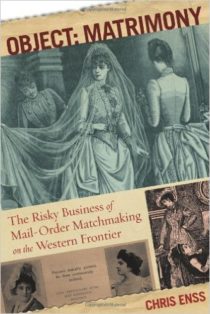1848 – Myra Maybelle Shirley, better known as Belle Starr, the “Bandit Queen” is born in Medoc, Missouri.
Death Row All Stars: A Story of Baseball, Corruption, and Murder.
Enter to win a copy of the book
Death Row All Stars: A Story of Baseball, Corruption, and Murder.

“No thrill equals that which comes when a home player sends the ball ringing off his bat safely to the outfield. As the number of bases gained by such a hit increases, so does the excitement mount. When one of those drives wins a game, its maker is a hero.”
The American West of the early 1900s was the scene of great change. The trans-continental railroad cut a swath through the country, pulling the population away from the East, bringing progress to and signs of the coming industrial age. Boomtowns were turning into cities; the ways of the west were disappearing and giving way to the inevitable intrusion of change.
But as life became more sophisticated and industrial, a simple and pure game captured the attention of a nation. It would become a national pastime, but in Wyoming in 1910 baseball was an obsession.
Every town, every camp had leagues or teams of their own. Every team had stars that could easily play alongside Honus Wagner or Ty Cobb. But there were no baseball stars as unique as the Wyoming State Penitentiary Death Row All Stars of Rawlins, Wyoming.
And the star of the All Stars, Joseph Seng.
From the moment he arrived at the penitentiary, Seng was known more for his baseball prowess than his murder conviction. Within moments of his incarceration, prison officials got around to the task of creating a team and building a place to play.
The concept of prison reform and prisoner welfare was nonexistent in 1910. Time on the field was a precious escape from day-to-day life that could be both extremely hellish and (for some) lavishly privileged. Corruption and graft ran rampant. Prisoners were forced to work for little or no wages in the prison broom factory, denied basic necessities, fed rancid food, and forced to work road crews. Others were allowed to openly wander the streets of Rawlins, hunt rabbits outside the prison walls, and reap the monetary windfall of betting on the All Stars.
For the players, baseball was their life, their saving grace. Inside their cell, they were rapists, robbers, burglars, and thieves. But on the playing field, they were fast, hard, and possessed an inside fast ball no one could hit.
Primarily off the strength of Seng’s arm (and his bat), the Death Row All Stars quickly became the talk of barrooms, brothels, and even political circles. Fortunes were being made by wagering in exchange for promises of time taken off their sentences and, for Seng, the possibility of a death penalty commutation.
For one cloudless Wyoming summer, residents of Rawlins boasted one of the finest baseball teams in the country. Scores of baseball fans came from all over the state, creating an abstract grandstand fan base. Socialites, merchants, and politicos sat alongside prospectors, ranchers, and drifters cheering for the men in the dark uniforms with “W-S-P” sewn on their chests.
To learn more about the All Stars and the games they played to save their lives read
The Death Row All Stars: A Story of Baseball, Corruption, and Murder.
Zack

Yesterday was one of those days. Most business calls I made turned out to be disastrous. Is the average person stupider than they were a generation ago? Or do you just run into more stupid people because fewer stupid people are getting eaten by bears? The work day blues followed me to Bible study last night and parked themselves right next to me as I began to teach a class of seventeen kids about the importance of loving one another. Just as the lesson started a five year old boy named Zack asked if he could lead the class in a song he learned to play on his small, Mickey Mouse guitar. Everyone happily agreed and he proudly came to the front of the room carrying his instrument and ready to serenade us all in a chorus of “Jesus Loves Me.” No sooner had we started to sing than Zack stopped us because he needed to tune his toy guitar. Wearing a serious expression he carefully turned the knobs on the handle of the guitar and strummed until he achieved just the right sound. The class respectfully watched him as though he were a classically trained musician preparing for a recital. No one laughed or cracked a smile. This was serious business for Zack. We began the song again and he beamed with pride. After an encore he returned to his seat and carefully laid his guitar next to him on the floor. That sweet, unassuming act of praise hung in the air for the duration of the class. Any irritation I was feeling when I arrived at Bible study left the minute Zack played. It made me happy and humbled me in the process. I’ve thought about Zack and his kind offering many times since yesterday. It made me realize how ungrateful and stupid I am at times. I’m praying today that I won’t get eaten by a bear. Play on, Zack!
And the Winner Is…
This Day…
The Murderous Mail-Order Bride
Enter now to win a book for history lovers and brides to be who believe the risk is worth it all – Object Matrimony: The Risky Business of Mail-Order Bride Matchmaking on the Western Frontier.

When Carroll B. Rablen, a thirty-four year old veteran of World War II from Tuttletown, California, advertised for a bride he imagined hearing from a woman who longed to spend their life with him hiking and enjoying the historic, scenic beauty of the Gold Country in Northern California. The ad he placed in a San Francisco matrimonial paper in June 1928 was answered by Eva Brandon. The thirty-three year-old Eva was living in Quanah, Texas when she received a copy of the matrimonial publication.
If Carroll had been less eager to marry he might have noticed the immature tone Eva’s letters possessed. If he’d taken the time to scrutinize her words he might have been able to recognize a flaw in her thinking. According to the July 14, 1929 edition of the Ogden, Utah newspaper the Ogden Standard-Examiner, one of Eva’s first correspondences demonstrated that not only did she seem much younger than thirty-three years old, but she also had a dark side. “Mr. Rablen, Dear Friend,” the letter began. “You wrote about a son I have. He has had no father since he was a month old. The father left me. I haven’t seen him. If a man leaves me I don’t want to see them. And I’ll make sure I can’t.”
Eva left Texas for California in late April 1929. She and Carroll were married the evening of April 29, 1929. The dance that followed the nuptials at the Tuttletown school house was well attended by Carroll’s friends and neighbors. They were happy he had found someone to share his life. Eva twirled around the room dancing with anyone who wanted to join her. She was elated with her situation. Carroll on the other hand chose to wait outside for his new bride in the car. According to the Ogden Standard Examiner, Carroll was slightly deaf and despondent over the other physical ailments that kept him from fully enjoying the festivities.
When Carroll’s father, Stephen Rablen began regaling guests with his rendition of the song “Turkey in the Straw” on his fiddle, Eva excused herself and went outside to visit with her husband. She took a tray of sandwiches and coffee to him. He smiled proudly at her and commented on how thoughtful it was for her to bring him some refreshments. Carroll helped himself to a cup of coffee, blew across the top of it to cool it down then took a sip. He made a bit of a face as if the coffee lacked something. He took another drink to determine what it needed.
To learn more about how mail-order bride Eva Brandon killed
her husband read
Object Matrimony: The Risky Business of Mail-Order Matchmaking on the Western Frontier.
This Day…
A Wife Wanted
Don’t wait. Enter now to win a book for history lovers and brides to be who believe the risk is worth it all – Object Matrimony: The Risky Business of Mail-Order Bride Matchmaking on the Western Frontier.

“I am a man of wealth and position,” said the widower Shyon Brane to the marriage broker, “and I seek a suitable mate. She must be handsome, cleanly, economical, industrious, and virtuous, a good cook she must be, a thrifty buyer, a capable housekeeper, and not easily stressed. She must know something of music and the arts, dance well and be able to discourse intelligently on history and philosophy withal, she must be cheerful and of affectionate disposition.”
“Lo,” said the marriage broker, “you come too late. One thousand years ago there was such a paragon but the gods took her to keep house for them. There is no wife for you, but the employment agency can supply you with a dozen domestics, who, in a measure, may meet your demands.”
Article placed in the Santa Fe New Mexican, Santa Fe, New Mexico, March 9, 1920.
To learn more about mail-order brides and their potential husbands read
Object Matrimony: The Risky Business of Mail-Order Matchmaking on the Western Frontier.
This Day…
Destined for Disappointment
Be a winner. Enter now to win a book for history lovers and brides to be who believe the risk is worth it all – Object Matrimony: The Risky Business of Mail-Order Bride Matchmaking on the Western Frontier.

Deacon Joe Sleet’s correspondence with the widow Nellie Wallace was full of promise for the future. When they began writing one another in late 1925, Mrs. Wallace had hoped to find a man who would love and care for her as her deceased husband once had. When she placed an ad in the Get Acquainted section of a western magazine and the deacon responded, she believed he was the answer to her heart’s longing. “I’m not a flapper,” her advertisement read, “but I would like to exchange letters with a man between the age of twenty-five and thirty-two. I want a husband good and true, there is a chance it might be you,” the notice concluded.
Twenty-two-year-old Nellie Wallace lived in Tchula, Mississippi, 1,500 miles from Joes Sleet’s home in El Paso, Texas. Of all the letters she received in reply to her ad, Joe’s struck her fancy completely. In a short time Nellie was writing Joe to the exclusion of anyone else. Through his letters she learned that he was a deacon in the Baptist church and that he was a widower. Nellie confided in him that she too was the victim of a sad romance, her husband having died some years ago.
The correspondence was hardly a month old before Joe had been granted permission to call his fair correspondent “Sweetheart.” Another week and respective photographs were exchanged; still another and a row of x’s appeared at the bottom of their letters. Another month passed and more letters were delivered at the Sleet home. In one of those letters Nellie admitted there was a “spark of love aglow” in her heart.
To learn what happened to Deacon Sleet and Nellie Wallace read
Object Matrimony: The Risky Business of Mail-Order Matchmaking on the Western Frontier.



